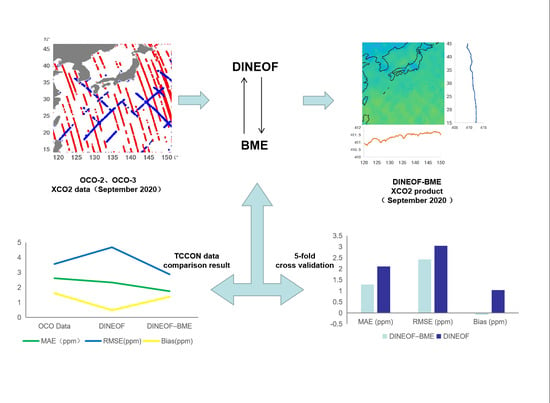Application and Analysis of XCO2 Data from OCO Satellite Using a Synthetic DINEOF–BME Spatiotemporal Interpolation Framework
Abstract
:1. Introduction
2. Data Sources and Research Scope
2.1. Data Sources
2.2. Research Scope
3. Data Processing and the Synthetic DINEOF–BME Interpolation Approach
3.1. Data Preprocessing
- (a)
- Outlier analysis: analyze the overall situation of XCO2.
- (b)
- Simple fusion: the daily XCO2 data of OCO-2 and OCO-3 were directly and simply fused. First, the resolution of the two data was processed as a 0.1 latitude and longitude by averaging the data points in the same grid. Due to the great difference in the orbits of the two satellites, the data of the two satellites were rarely duplicated.
- (c)
- Monthly average processing: The time resolution of XCO2 data fused by OCO-2 and OCO-3 is daily, but the time range of this study is long. Therefore, the time resolution is adjusted to monthly, and the XCO2 data within the same grid point are averaged every month.
3.2. The DINEOF Method
- Determine the morphology of spatiotemporal variable field ;
- Find the covariance matrix of : ;
- Calculate the eigenvalues and eigenvectors of matrix A;
- The eigenvalues are arranged in ascending order to obtain the eigenvalue matrix, and the eigenvector matrix is changed accordingly;
- Calculate time function;
- Select the first N effective space typical fields and combine them with the corresponding time coefficients for modal calculation and output.
3.3. The BME Method
- -
- The prior stage considers the core or general knowledge base G–KB (including spatiotemporal covariance models, physical laws, and scientific theories). The general knowledge base in this study is the covariance function (Equation (10)). The Spatiotemporal Random Field (STRF) is a collection of individual Random Variables (RV).
- -
- The intermediate stage involves the site-specific knowledge base (S-KB ‘Private data’ in Figure 2) consisting of hard (or accurate) data and soft data (i.e., data with inherent uncertainty, such as remote sensing data with low precision and information based on limited experience). In this study, the hard data were monthly average XCO2 data after the fusion of pretreated OCO-2 and OCO-3, whereas interpolating data processed by the DINEOF method will be used as soft data after removing the fusion data of OCO-2 and OCO-3.
- -
- The posterior stage integrates the two main knowledge bases above, G and S, to obtain the posterior probability density of the XCO2 spatiotemporal distribution or , where is the total KB expressed as the union of the core G and the site-specific S bases.
3.4. The Synthetic DINEOF–BME Interpolation Approach
3.5. Validation and Comparison
4. Results
4.1. XCO2 Data Interpolation Results
4.2. Comparison and Validation Analysis
4.2.1. Spatiotemporal Model Analysis
4.2.2. Cross Validation
4.2.3. Comparative Analysis
5. Discussion
5.1. Methodology
5.2. Product Analysis
5.3. Prospects and Expectations
6. Conclusions
Author Contributions
Funding
Data Availability Statement
Conflicts of Interest
References
- Grubler, A. IPCC Fifth Assessment Report. Weather 2014, 68, 310. [Google Scholar]
- Liu, H.; Rodriguez, G. Human Activities and Global Warming: A Cointegration Analysis. Environ. Model. Softw. 2003, 20, 761–773. [Google Scholar] [CrossRef]
- Robinson, I.S. Discovering the Ocean from Space: The Unique Applications of Satellite Oceanography; Springer: Berlin/Heidelberg, Germany, 2010. [Google Scholar]
- Solomon, S. Working Group 1 contribution to the IPCC fifth assessment report. In Climate Change 2013: The Physical Science Basis; Cambridge University Press: Cambridge, UK, 2007. [Google Scholar]
- Akihiko, K.; Hiroshi, S.; Masakatsu, N.; Takashi, H. Thermal and near infrared sensor or carbon observation Fourier-transform spectrometer on the Greenhouse Gases Observing Satellite for greenhouse gases monitoring. Appl. Opt. 2009, 48, 6716–6733. [Google Scholar] [CrossRef]
- Frankenber, C.; Pollock, R.; Lee, R.A.M.; Rosenberg, R.; Blavier, J.-F.; Crisp, D.; O’Dell, C.W. The Orbiting Carbon Observatory (OCO-2): Spectrometer performance evaluation using pre-launch direct sun measurements. Atmos. Meas. Tech. 2015, 8, 301–313. [Google Scholar] [CrossRef]
- Yokota, T.; Yoshida, Y.; Eguchi, N.; Ota, Y.; Tanaka, T.; Watanabe, H.; Maksyutov, S. Global Concentrations of CO2 and CH4 Retrieved from GOSAT: First Preliminary Results. Sola 2009, 5, 160–163. [Google Scholar] [CrossRef]
- Houweling, S.; Hartmann, W.; Aben, I.; Schrijver, H.; Skidmore, J.; Roelofs, G.J.; Breon, F.M. Evidence of systematic errors in sciamachy-observed CO2 due to aerosols. Atmos. Chem. Phys. 2005, 5, 3003–3013. [Google Scholar] [CrossRef]
- Velazco, V.A.; Buchwitz, M.; Bovensmann, H.; Reuter, M.; Schneising, O.; Heymann, J.; Krings, T.; Krings, T.; Burrows, J.P. Towards space based verification of CO2 emissions from strong localized sources: Fossil fuel power plant emissions as seen by a CarbonSat constellation. Atmos. Meas. Tech. Discuss. 2011, 4, 5147–5182. [Google Scholar] [CrossRef]
- Cai, Z.N.; Liu, Y.; Yang, D.X. Analysis of XCO2 retrieval sensitivity using simulated Chinese Carbon Satellite (TanSat) measurements. Sci. China Earth Sci. 2014, 57, 1919–1928. [Google Scholar] [CrossRef]
- Guo, L.; Lei, L.; Zeng, Z.; Zou, P.; Liu, D.; Zhang, B. Evaluation of Spatio-Temporal Variogram Models for Mapping Xco(2) Using Satellite Observations: A Case Study in China. IEEE J. Sel. Top. Appl. Earth Obs. Remote Sens. 2015, 8, 376–385. [Google Scholar] [CrossRef]
- Zeng, Z.; Lei, L.; Hou, S.; Li, L. A spatio-temporal interpolation approach for the FTS SWIR product of XCO2 data from GOSAT. In Proceedings of the Geoscience & Remote Sensing Symposium IEEE, Munich, Germany, 22–27 July 2012. [Google Scholar]
- Azcarate, A.A.; Barth, A.; Beckers, J.M.; Weisberg, R.H. Multivariate reconstruction of missing data in sea surface temperature, chlorophyll, and wind satellite fields. J. Geophys. Res. Ocean. 2007, 112, C03008. [Google Scholar] [CrossRef]
- Azcarate, A.A.; Barth, A.; Sirjacobs, D.; Lenartz, F.; Beckers, J.M. Data Interpolating Empirical Orthogonal Functions (DINEOF): A tool for geophysical data analyses. Mediterr. Mar. Sci. 2011, 12, 1–5. [Google Scholar] [CrossRef] [Green Version]
- Christakos, G. A Bayesian/maximum-entropy view to the spatial estimation problem. Math. Geol. 1990, 22, 763–777. [Google Scholar] [CrossRef]
- Christakos, G. Modern Spatiotemporal Geostatistics; Oxford University Press: New York, NY, USA, 2000. [Google Scholar]
- He, J.; Kolovos, A. Bayesian maximum entropy approach and its applications: A review. Stoch. Environ. Res. Risk Assess. 2017, 32, 859–877. [Google Scholar] [CrossRef]
- Lang, Y.; Christakos, G. Ocean pollution assessment by integrating physical law and site-specific data. Environmetrics 2019, 30, e2547. [Google Scholar] [CrossRef]
- He, J.; Chen, Y.; Wu, J.; Stow, D.A.; Christakos, G. Space-time chlorophyll-a retrieval in optically complex waters that accounts for remote sensing and modeling uncertainties and improves remote estimation accuracy. Water Res. 2020, 171, 115403. [Google Scholar] [CrossRef] [PubMed]
- He, M.; He, J.; Christakos, G. Improved Space-Time Sea Surface Salinity Mapping in Western Pacific Ocean Using Contingogram Modeling. Stoch. Environ. Res. Risk Assess. 2020, 34, 355–368. [Google Scholar] [CrossRef]
- Pearson, K. LIII. On lines and planes of closest fit to systems of points in space. Philos. Mag. 1901, 2, 559–572. [Google Scholar] [CrossRef]
- Azcarate, A.A.; Barth, A.; Rixen, M.; Beckers, J.M. Reconstruction of incomplete oceanographic data sets using empirical orthogonal functions: Application to the Adriatic Sea surface temperature. Ocean Model. 2005, 9, 325–346. [Google Scholar] [CrossRef]
- Crisp, D.; Pollock, H.R.; Rosenberg, R.; Chapsky, L.; Wunch, D. The on-orbit performance of the Orbiting Carbon Observatory-2 (OCO-2) instrument and its radiometrically calibrated products. Atmos. Meas. Tech. 2017, 10, 1–45. [Google Scholar] [CrossRef]
- Taylor, T.E.; Eldering, A.; Merrelli, A.; Kiel, M.; Yu, S. OCO-3 early mission operations and initial (vEarly) XCO2 and SIF retrievals. Remote Sens. Environ. 2020, 251, 112032. [Google Scholar] [CrossRef]
- Eldering, A.; Taylor, T.E.; O’Dell, C.W.; Pavlick, R. The OCO-3 mission: Measurement objectives and expected performance based on 1 year of simulated data. Atmos. Meas. Tech. 2019, 12, 2341–2370. [Google Scholar] [CrossRef] [Green Version]
- Wunch, D.; Toon, G.C.; Blavier, J.-F.L.; Washenfelder, R.A.; Notholt, J.; Connor, B.J.; Griffith, D.W.T.; Sherlock, V.; Wennberg, P.O. The Total Carbon Column Observing Network. Philos. Trans. R. Soc. A Math. Phys. Eng. Sci. 2011, 369, 2087–2112. [Google Scholar] [CrossRef] [PubMed]
- Wunch, D.; Toon, G.C.; Blavier, J.F.L.; Washenfelder, R.A.; Notholt, J.; Connor, B.J.; Griffith, D.W.; Sherlock, V.; Wennberg, P.O. The Total Carbon Column Observing Network’s GGG2014 Data Version, Pasadena, California. Philos. Trans. R. Soc. A Math. Phys. Eng. Sci. 2015, 369, 2087–2112. [Google Scholar] [CrossRef] [PubMed]
- Christakos, G. Spatiotemporal Random Fields: Theory and Applications; Elsevier: Amsterdam, The Netherlands, 2017. [Google Scholar]
- Bogaert, P.; Christakos, G.; Jerrett, M.; Yu, H.L. Spatiotemporal modelling of ozone distribution in the State of California. Atmos. Environ. 2009, 43, 2471–2480. [Google Scholar] [CrossRef]
- Gao, S.G.; Zhu, Z.L.; Liu, S.M.; Jin, R.; Yang, G.C.; Tan, L. Estimating the spatial distribution of soil moisture based on Bayesian maximum entropy method with auxiliary data from remote sensing (SCI). Int. J. Appl. Earth Obs. Geoinf. 2014, 32, 54–66. [Google Scholar]
- Lee, S.J.; Balling, R.; Gober, P. Bayesian maximum entropy mapping and the soft data problem in urban climate research. Ann. Assoc. Am. Geogr. 2008, 98, 309–322. [Google Scholar] [CrossRef]
- Li, X.; Li, P.; Zhu, H. Coal seam surface modeling and updating with multisource data integration using Bayesian Geostatistics. Eng. Geol. 2013, 164, 208–221. [Google Scholar] [CrossRef]
- Yu, H.L.; Kolovos, A.; Christakos, G.; Chen, J.C.; Warmerdam, S.; Dev, B. Interactive spatiotemporal modelling of health systems: The SEKS-GUI framework. Stoch. Environ. Res. Risk Assess. 2007, 21, 555–572. [Google Scholar] [CrossRef]
- Kohavi, R. A study of cross-validation and bootstrap for accuracy estimation and model selection. In Proceedings of the International Joint Conference on Artificial Intelligence, Montreal, QC, Canada, 20–25 August 1995; Morgan Kaufmann Publishers Inc.: Burlington, MA, USA, 1995. [Google Scholar]
- Beckers, J.M.; Barth, A.; Azcarate, A.A. DINEOF reconstruction of clouded images including error maps. Application to the Sea-Surface Temperature around Corsican Island. Ocean Sci. 2006, 2, 183–199. [Google Scholar] [CrossRef]
- Azcarate, A.A.; Barth, A.; Parard, G.; Beckers, J. Analysis of SMOS sea surface salinity data using DINEOF. Remote Sens. Environ. 2016, 180, 137–145. [Google Scholar] [CrossRef]
- Bogaert, P.; D’Or, D. Estimating Soil Properties from thematic Soil Maps: The Bayesian Maximum Entropy Approach. Soil Sci. Soc. Am. J. 2002, 66, 1492–1500. [Google Scholar] [CrossRef]
- Christakos, G. On the assimilation of uncertain physical knowledge bases: Bayesian and non-Bayesian techniques. Adv. Water Resour. 2002, 25, 1257–1274. [Google Scholar] [CrossRef]
- Christakos, G.; Kolovos, A.; Serre, M.L.; Vukovich, F. Total ozone mapping by integrating databases from remote sensing instruments and empirical models. Geosci. Remote Sens. IEEE Trans. 2004, 42, 991–1008. [Google Scholar] [CrossRef]
- Jiang, Q.; He, J.; Wu, J.; Hu, X.; Ye, G.; Christakos, G. Assessing the Severe Eutrophication Status and Spatial Trend in the Coastal Waters of Zhejiang Province (China). Limnol. Oceanogr. 2018, 64, 3–17. [Google Scholar] [CrossRef]
- He, J.; Christakos, G.; Wu, J.; Li, M.; Leng, J. Spatiotemporal BME Characterization and Mapping of Sea Surface Chlorophyll in Chesapeake Bay (USA) Using Auxiliary Sea Surface Temperature Data. Sci. Total Environ. 2021, 794, 148670. [Google Scholar] [CrossRef] [PubMed]
- Cong, Z.; Shi, R.; Wei, G. Interpolation of XCO2 retrieved from GOSAT in China using fixed rank kriging. In Proceedings of the SPIE-The International Society for Optical Engineering, San Diego, CA, USA, 24 September 2013; Volume 8869, pp. 281–291. [Google Scholar] [CrossRef]
- Jing, Y.; Shi, J.; Wang, T. Mapping global land XCO2 from measurements of GOSAT and SCIAMACHY by using kriging interpolation method. In Proceedings of the IGARSS 2014-2014 IEEE International Geoscience and Remote Sensing Symposium, Quebec City, QC, Canada, 13–18 July 2014. [Google Scholar]
- Liang, A.; Gong, W.; Ge, H.; Xiang, C. Comparison of Satellite-Observed XCO2 from GOSAT, OCO-2, and Ground-Based TCCON. Remote Sens. 2017, 9, 1033. [Google Scholar] [CrossRef]
- Du, S.; Liu, L.; Liu, X.; Zhang, X.; Bi, Y.; Zhang, L. Retrieval of global terrestrial solar-induced chlorophyll fluorescence from TanSat satellite. Sci. Bull. 2018, 22, 1502–1512. [Google Scholar] [CrossRef]
- Pillai, D.; Buchwitz, M.; Bovensmann, H.; Reuter, M.; Burrows, J. Inferring source and sink of atmospheric CO2 at high-resolution from space: A mesoscale modeling approach using inverse technique. In Proceedings of the EGU General Assembly Conference Abstracts, Vienna, Austria, 7–12 April 2012. [Google Scholar]
- Wang, T.; Shi, J.; Jing, Y.; Zhao, T.; Ji, D.; Xiong, C. Combining XCO2 Measurements Derived from SCIAMACHY and GOSAT for Potentially Generating Global CO2 Maps with High Spatiotemporal Resolution. PLoS ONE 2012, 9, e0148152. [Google Scholar] [CrossRef]
- Aben, I.; Hasekamp, O.; Hartmann, W. Uncertainties in the space-based measurements of CO2 columns due to scattering in the Earth’s atmosphere. J. Quant. Spectrosc. Radiat. Transf. 2007, 104, 450–459. [Google Scholar] [CrossRef]
- Butz, A.; Hasekamp, O.P.; Frankenberg, C.; Aben, I. Retrievals of atmospheric CO2 from simulated space-borne measurements of backscattered near-infrared sunlight: Accounting for aerosol effects. Appl. Opt. 2009, 48, 3322–3336. [Google Scholar] [CrossRef]
- Guerlet, S. Impact of aerosol and thin cirrus on retrieving and validating XCO2 from GOSAT shortwave infrared measurements. J. Geophys. Res. Atmos. 2013, 118, 4887–4905. [Google Scholar] [CrossRef] [Green Version]
- Takagi, H. Characteristics of multi-year-long regional CO2 fluxes estimated from GOSAT XCO2 retrievals. In Agu Fall Meeting Abstracts; American Geophysical Union: Washington, DC, USA, 2015. [Google Scholar]
- Camy-Peyret, C.; Bureau, J.; Payan, S. Evolution of SST and XCO2 in the summer ice free Arctic Ocean: Is IASI able to contribute to climate change studies? In Proceedings of the 4th IASI International Conference, Antibes Juan-Les-Pins, France, 20 April 2016. [Google Scholar]
- Jiang, X. Carbon Dioxide Induced Ocean Climatic Change and Tracer Experiment with an Atmosphere-Ocean General Circulation Model. Ph.D. Thesis, University of Illinois, Chicago, IL, USA, 1991. [Google Scholar]
- Ferrari MC, O.; Mccormick, M.I.; Watson, S.-A.; Meekan, M.G.; Munday, P.L.; Chivers, D.P. Predation in High CO2 Waters: Prey Fish from High-Risk Environments are Less Susceptible to Ocean Acidification. Integr. Comp. Biol. 2017, 57, 55. [Google Scholar] [CrossRef] [PubMed] [Green Version]
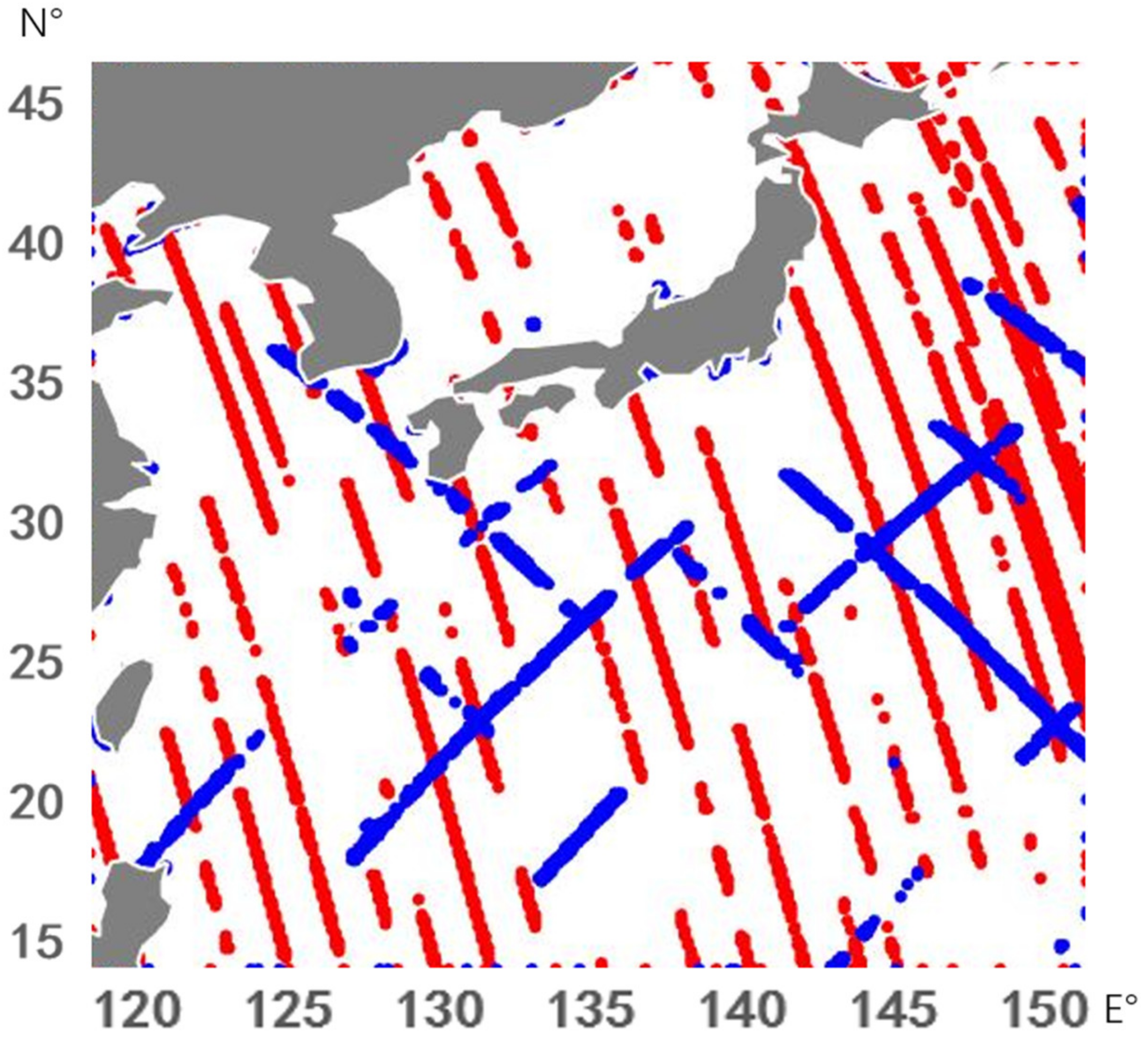
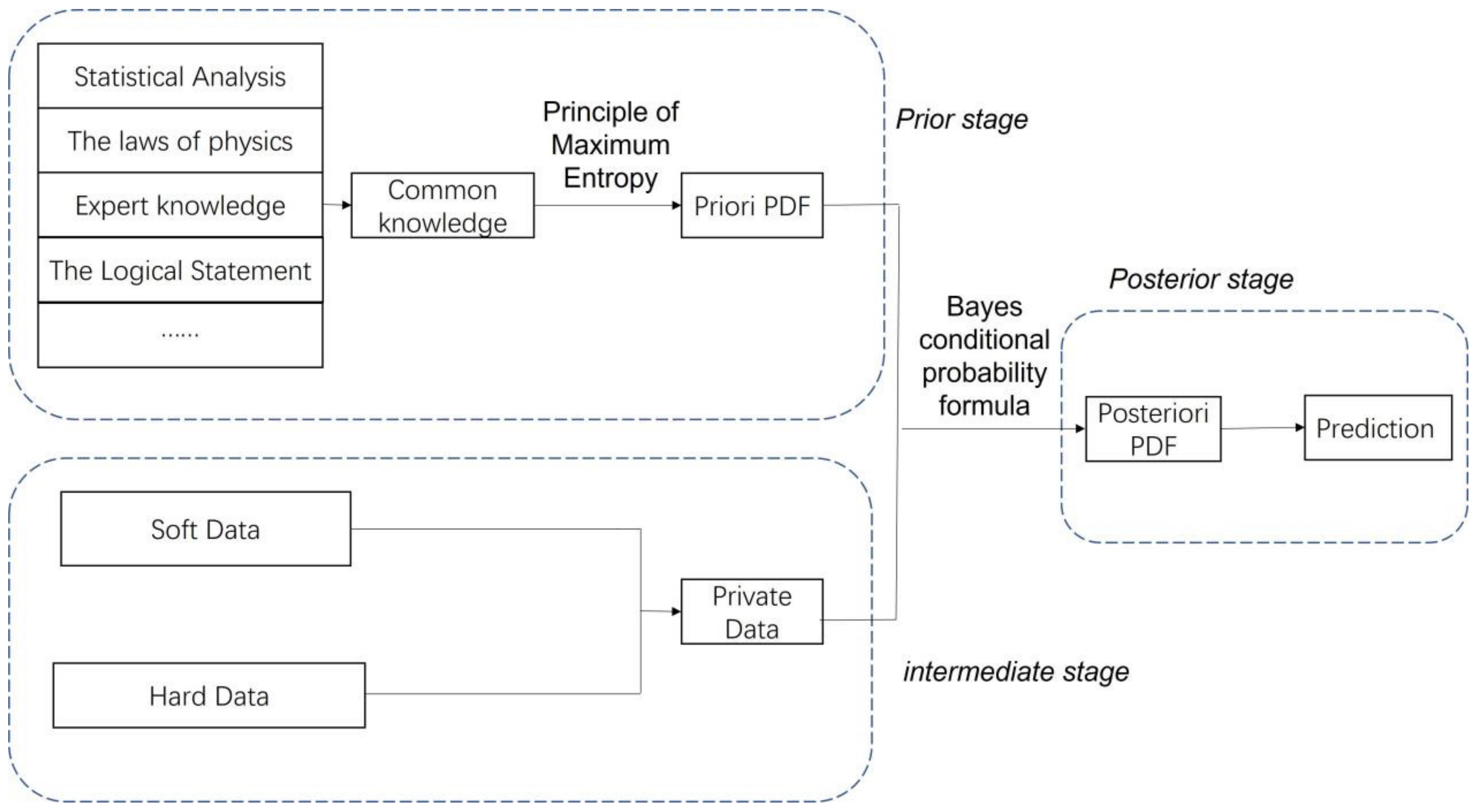
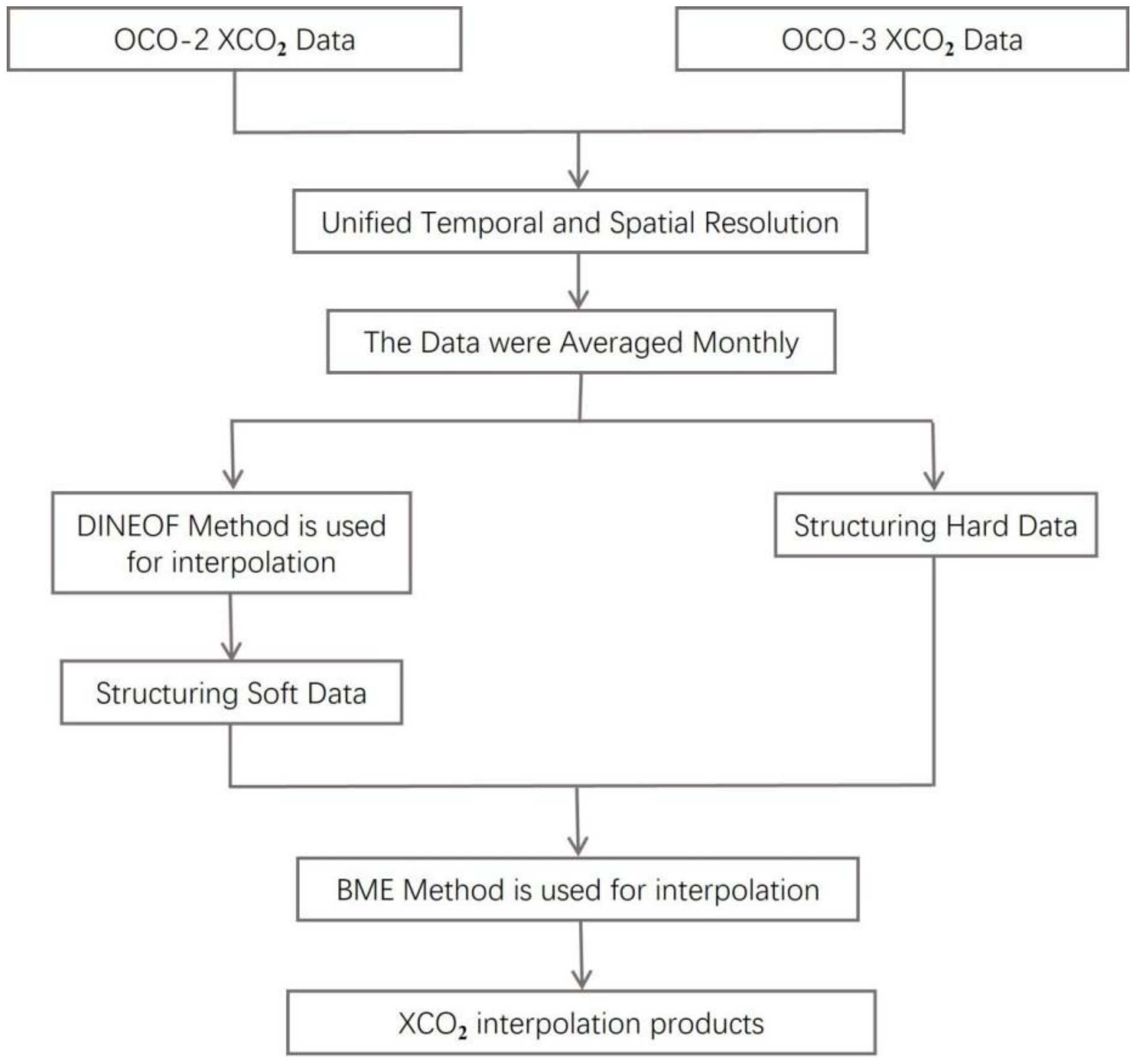
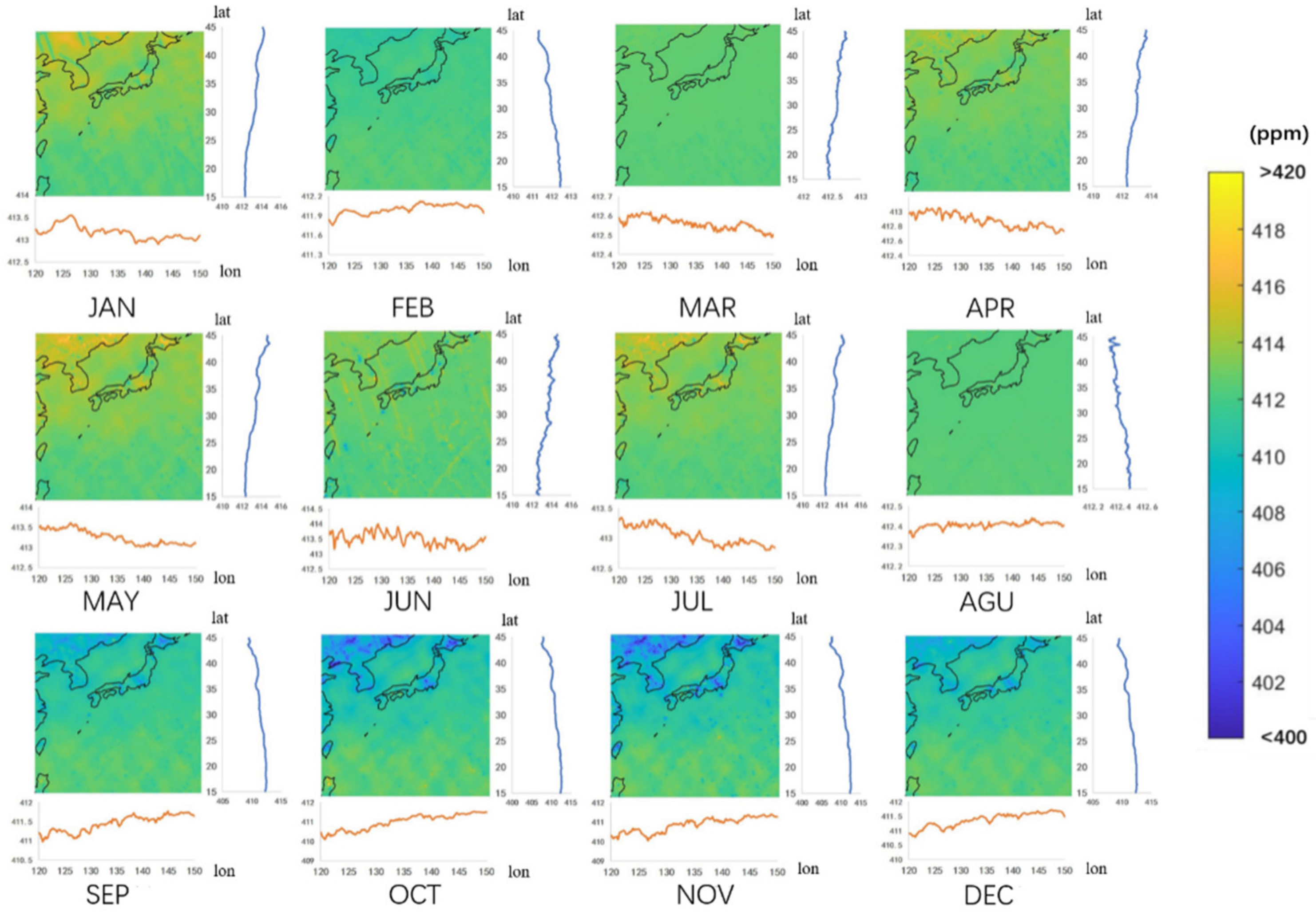
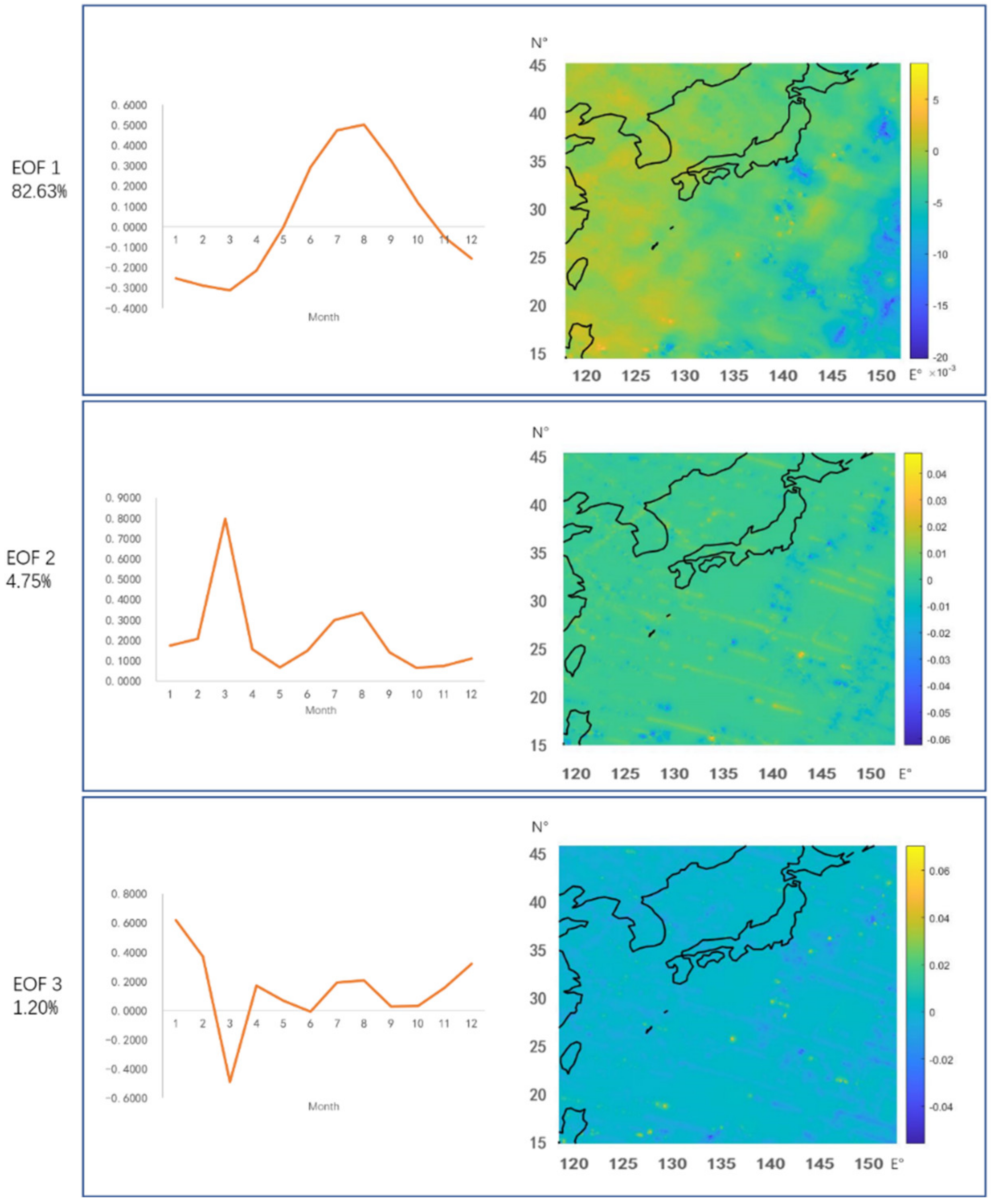
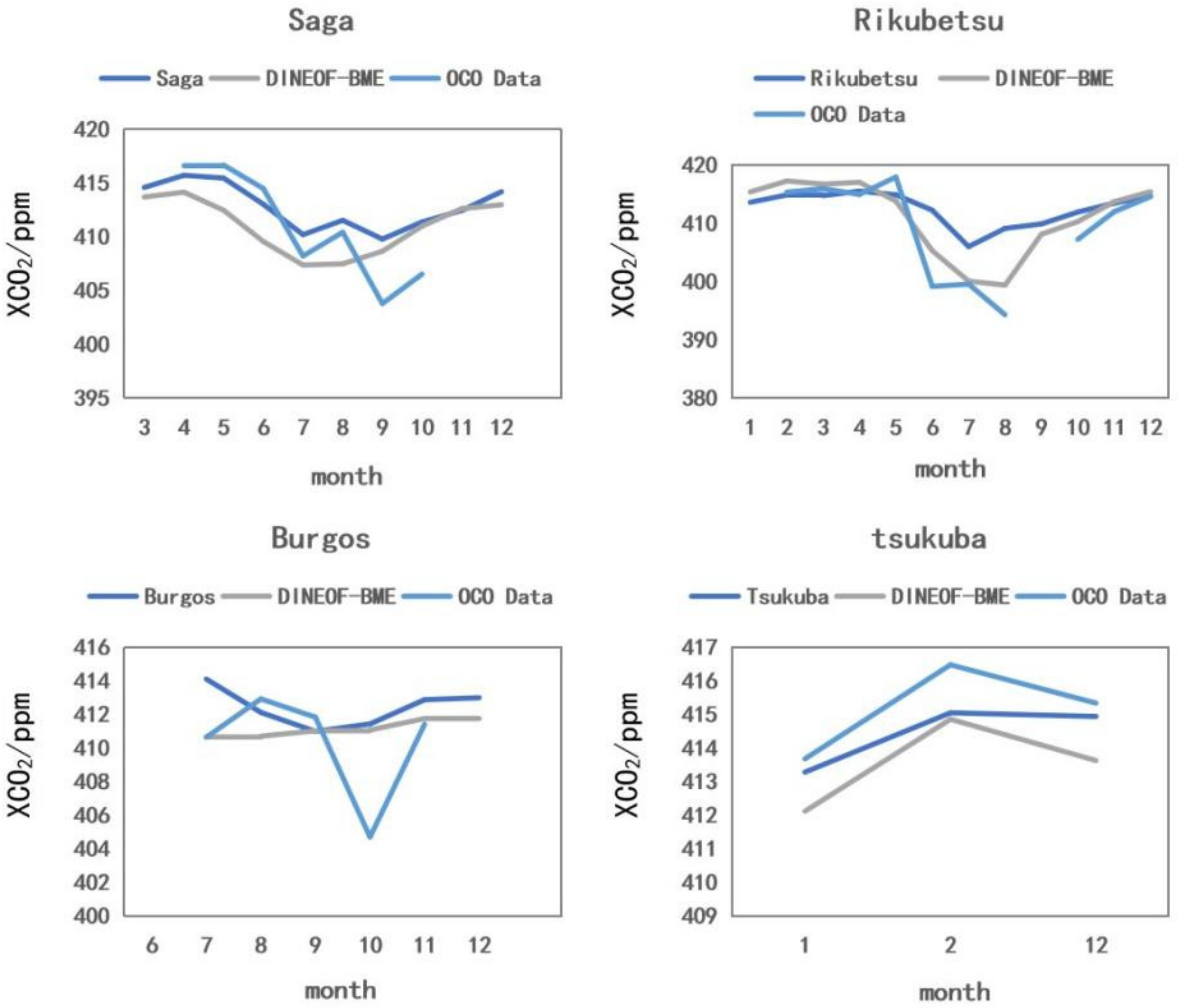
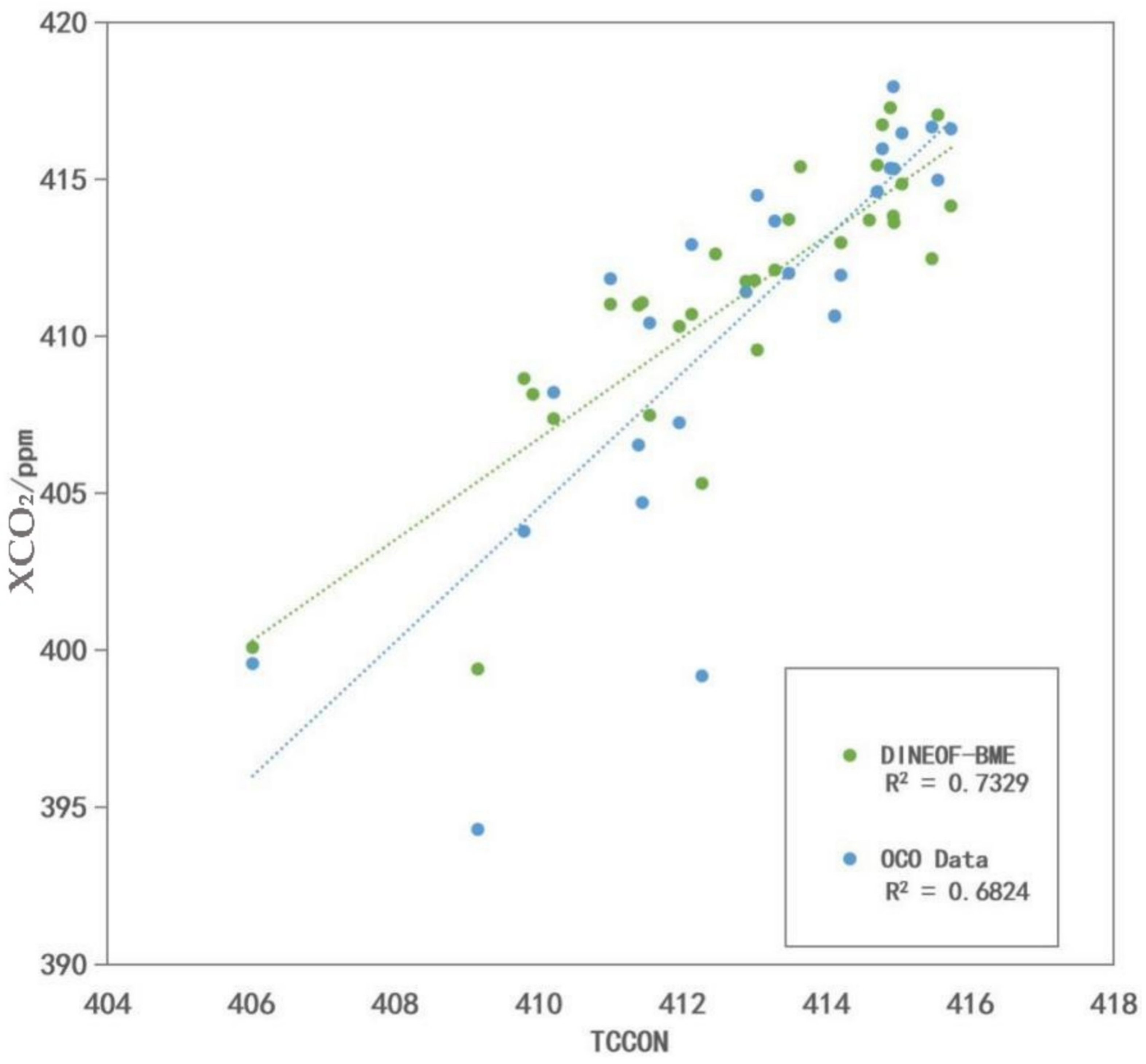
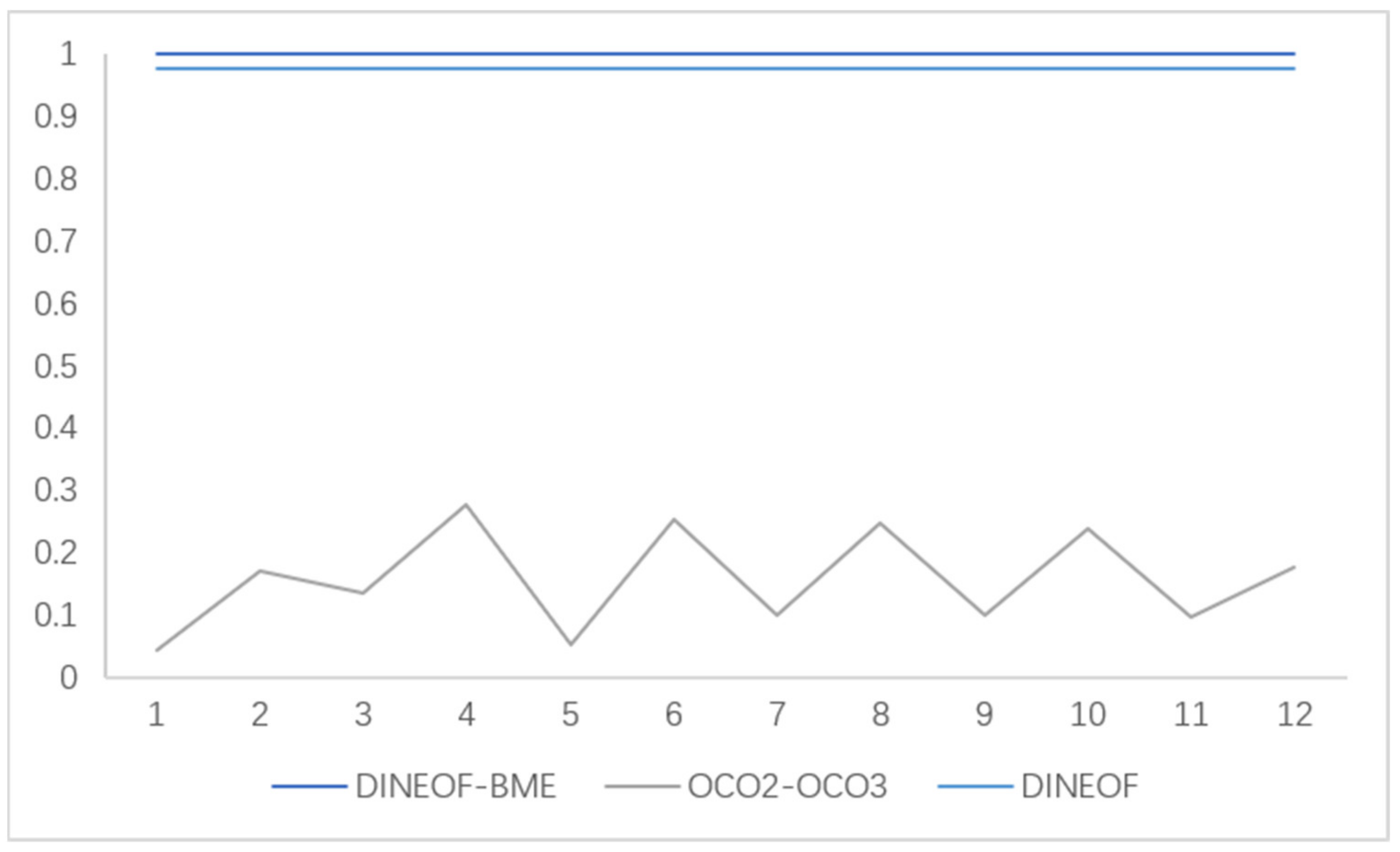
| Methodology | MAE (ppm) | RMSE (ppm) | Bias (ppm) |
|---|---|---|---|
| DINEOF–BME | 1.285 | 2.422 | −0.085 |
| DINEOF | 2.106 | 3.046 | 1.035 |
| Site | Burgos | Saga | Tsukuba | Rikubetsu | Average | |
|---|---|---|---|---|---|---|
| OCO Data | MAE (ppm) | 2.663 | 2.468 | 0.741 | 4.591 | 2.616 |
| RMSE (ppm) | 3.489 | 3.043 | 0.886 | 6.846 | 3.566 | |
| Bias (ppm) | 2.003 | 1.579 | −0.741 | 3.649 | 1.622 | |
| DINEOF | MAE (ppm) | 1.430 | 1.657 | 1.041 | 5.208 | 2.334 |
| RMSE (ppm) | 2.742 | 3.921 | 1.216 | 10.847 | 4.682 | |
| Bias (ppm) | −0.581 | 0.797 | 0.215 | 1.500 | 0.483 | |
| DINEOF–BME | MAE (ppm) | 1.266 | 1.87 | 0.889 | 2.981 | 1.751 |
| RMSE (ppm) | 2.799 | 5.155 | 1.036 | 2.517 | 2.877 | |
| Bias (ppm) | 1.255 | 1.835 | 0.889 | 1.537 | 1.379 |
| OCO-2 | OCO-3 | GOSAT | Tansat | CarbonSat | SCIAMACHY |
|---|---|---|---|---|---|
| 1.3 km × 2.3 km | 1.6 km × 2.2 km | 10.5 km × 10.5 km | 2 km × 2 km | 2 km × 2 km | 60 km × 30 km |
Publisher’s Note: MDPI stays neutral with regard to jurisdictional claims in published maps and institutional affiliations. |
© 2022 by the authors. Licensee MDPI, Basel, Switzerland. This article is an open access article distributed under the terms and conditions of the Creative Commons Attribution (CC BY) license (https://creativecommons.org/licenses/by/4.0/).
Share and Cite
Jiang, Y.; Gao, Z.; He, J.; Wu, J.; Christakos, G. Application and Analysis of XCO2 Data from OCO Satellite Using a Synthetic DINEOF–BME Spatiotemporal Interpolation Framework. Remote Sens. 2022, 14, 4422. https://doi.org/10.3390/rs14174422
Jiang Y, Gao Z, He J, Wu J, Christakos G. Application and Analysis of XCO2 Data from OCO Satellite Using a Synthetic DINEOF–BME Spatiotemporal Interpolation Framework. Remote Sensing. 2022; 14(17):4422. https://doi.org/10.3390/rs14174422
Chicago/Turabian StyleJiang, Yutong, Zekun Gao, Junyu He, Jiaping Wu, and George Christakos. 2022. "Application and Analysis of XCO2 Data from OCO Satellite Using a Synthetic DINEOF–BME Spatiotemporal Interpolation Framework" Remote Sensing 14, no. 17: 4422. https://doi.org/10.3390/rs14174422
APA StyleJiang, Y., Gao, Z., He, J., Wu, J., & Christakos, G. (2022). Application and Analysis of XCO2 Data from OCO Satellite Using a Synthetic DINEOF–BME Spatiotemporal Interpolation Framework. Remote Sensing, 14(17), 4422. https://doi.org/10.3390/rs14174422







